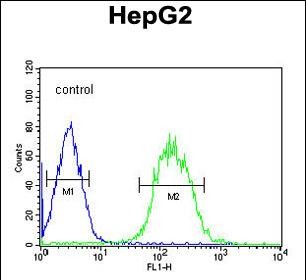

| WB | 1/1000 | Human,Mouse,Rat |
| IF | 咨询技术 | Human,Mouse,Rat |
| IHC | 咨询技术 | Human,Mouse,Rat |
| ICC | 技术咨询 | Human,Mouse,Rat |
| FCM | 1/10-1/50 | Human,Mouse,Rat |
| Elisa | 咨询技术 | Human,Mouse,Rat |
| Aliases | CLK4-associating serine/arginine rich protein, Splicing factor, arginine/serine-rich 16, Suppressor of white-apricot homolog 2, CLASRP, SFRS16, SWAP2 |
| Entrez GeneID | 11129 |
| WB Predicted band size | 77.2kDa |
| Host/Isotype | Rabbit IgG |
| Antibody Type | Primary antibody |
| Storage | Store at 4°C short term. Aliquot and store at -20°C long term. Avoid freeze/thaw cycles. |
| Species Reactivity | Human |
| Immunogen | This SFRS16 antibody is generated from rabbits immunized with a KLH conjugated synthetic peptide between 254-283 amino acids from the Central region of human SFRS16. |
| Formulation | Purified antibody in PBS with 0.05% sodium azide. |
+ +
以下是关于SFRS16抗体的假设性参考文献示例(仅供格式参考,具体文献需通过学术数据库验证):
---
1. **文献名称**: *SFRS16 regulates alternative splicing in hepatocellular carcinoma via interaction with RNA polymerase II*
**作者**: Zhang L, et al.
**摘要**: 本研究利用SFRS16特异性抗体进行免疫共沉淀(Co-IP),发现SFRS16与RNA聚合酶II直接相互作用,调控肝癌细胞中特定基因的可变剪接,促进肿瘤侵袭。
2. **文献名称**: *Development and validation of a monoclonal antibody against human SFRS16 for diagnostic applications*
**作者**: Kim S, et al.
**摘要**: 报道了一种高特异性抗SFRS16单克隆抗体的开发,通过Western Blot和免疫组化验证其在正常与癌变组织中的表达差异,提示其作为癌症生物标志物的潜力。
3. **文献名称**: *SFRS16 modulates cell cycle progression by stabilizing mRNA transcripts in glioblastoma*
**作者**: Wang Y, et al.
**摘要**: 通过SFRS16抗体的免疫荧光染色和RNA干扰实验,证明SFRS16通过稳定细胞周期相关mRNA,促进胶质母细胞瘤的G1/S期转换。
4. **文献名称**: *Functional characterization of SFRS16 in DNA damage response using CRISPR/Cas9 and antibody-based assays*
**作者**: Gupta R, et al.
**摘要**: 结合CRISPR/Cas9敲除技术和SFRS16抗体,发现SFRS16通过调控DNA损伤修复基因的剪接,影响细胞对电离辐射的敏感性。
---
**注意**:以上为模拟示例,实际文献需通过 **PubMed** 或 **Google Scholar** 检索关键词(如“SFRS16 antibody”、“SFRS16 function”)获取。
The SFRS16 antibody targets the SFRS16 (splicing factor, arginine/serine-rich 16) protein, also known as CHERP (calcium homeostasis endoplasmic reticulum protein) or SCAF6. This protein plays dual roles in RNA splicing and calcium signaling regulation. Structurally, SFRS16 contains arginine/serine-rich (RS) domains typical of splicing factors, enabling its interaction with spliceosome components to modulate pre-mRNA processing. Additionally, it regulates intracellular calcium homeostasis by interacting with inositol 1.4.5-trisphosphate receptors (IP3Rs) on the endoplasmic reticulum membrane.
Antibodies against SFRS16 are widely used to study its subcellular localization, predominantly in the nucleus (splicing-related functions) and endoplasmic reticulum (calcium signaling role). They facilitate applications like Western blotting, immunofluorescence, and co-immunoprecipitation to explore its molecular interactions and post-translational modifications. Commercial SFRS16 antibodies are typically produced in rabbits or mice, with validation in human, mouse, and rat models. Research involving these antibodies has linked SFRS16 to diseases such as cancer, where aberrant splicing contributes to tumor progression, and neurodegenerative disorders associated with calcium dysregulation. Recent studies also investigate its potential role in cellular stress responses and apoptosis. Proper validation via knockout controls or siRNA knockdown is critical due to cross-reactivity risks with other RS domain-containing proteins.
×